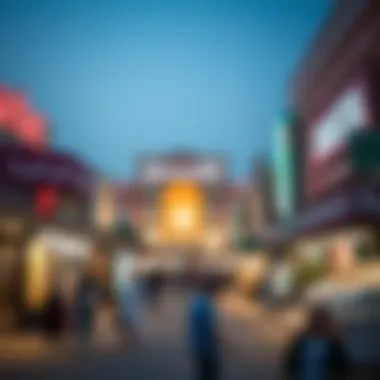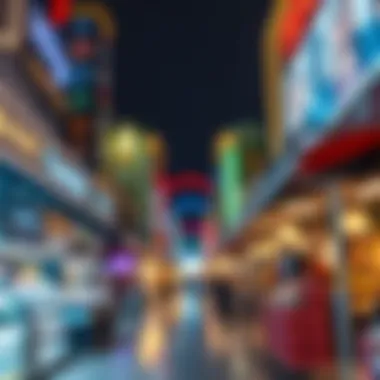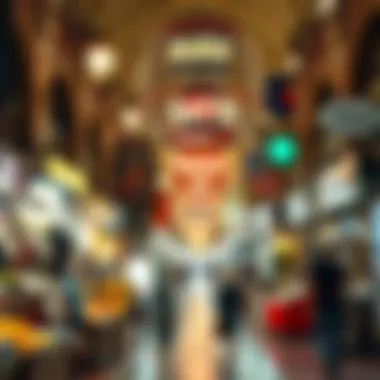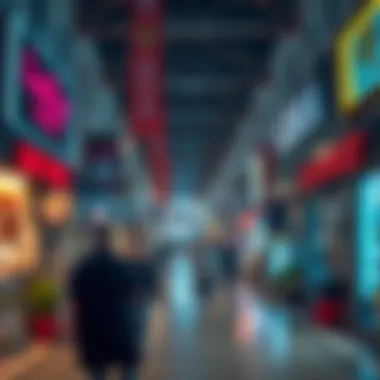Karama Market: A Cultural and Economic Hub in Dubai


Intro
Tucked away in the bustling heart of Dubai, Karama Market is much more than just a shopping destination; it's a living tapestry of culture, history, and economic opportunity. The market has long been a key part of the local landscape, showcasing the rich diversity of the city's population through its shops, food stalls, and street vendors. Understanding Karama Market is essential for anyone wishing to engage with Dubai's real estate scene or its vibrant heritage.
In this article, we will take a closer look at the property market within the vicinity of Karama, unpacking current trends and key performance indicators that reflect its growth. We will also explore the investment opportunities that the area presents, including those coveted emerging neighborhoods and the ever-debated pros and cons of buying vs. renting in this dynamic locality. With its distinctive charm, the market is poised to attract interest from not just tourists and local shoppers, but also from investors keen to tap into Dubai's economic momentum.
Prelude to Karama Market
Karama Market is more than just a shopping space; it reflects the pulse of Dubai's rich culture and community life. Known for its vibrant atmosphere, bustling alleys, and diverse offerings, this market is a significant player in the day-to-day lives of the locals and a must-visit for tourists. The importance of diving deep into the realm of Karama Market lies in understanding its multifaceted role in shaping the social fabric and economic structure of the city.
Geographical Context
Karama is nestled in the heart of Dubai, bordered by other lively neighborhoods like Bur Dubai and Satwa. The market sits gracefully on the main thoroughfare, which connects major roadways and public transport, making it easily accessible for visitors from all walks of life. Its location is pivotal as it stands at the juncture of old and new Dubai. From getting a glimpse of traditional architecture to witnessing the surge of modernity, one can experience two worlds in one visit.
The district is also strategically positioned close to several residential areas, drawing in a large crowd of everyday shoppers who frequent the market for their shopping needs. The market boasts proximity to the Dubai Metro, making it a breeze for both locals and tourists to hop on a train and arrive at this vibrant hub.
Historical Background
The roots of Karama Market stretch back several decades. Initially, it blossomed from a small trading post, where merchants sold textiles and spices from across the Middle East, India, and further afield. Over the years, it has evolved into a veritable treasure trove of goods, drawing in people from various cultural backgrounds.
Originally, much of the trade here was informal and consisted of local artisans and traders showcasing their wares. The market managed to retain a sense of authenticity amidst rapid urban development. As the city grew, so did the market, becoming an integral part of Dubai's identity. In recent years, efforts have been made to preserve its historical essence, allowing the stories and heritage of the area to shine through the everyday business hustle and bustle.
"Karama Market isn't just a place to shop; it's where cultures collide, creating a mosaic of experiences."
Through exploring its historical narrative, one realizes that Karama Market is not merely a shopping district but a venue where memories and conversations are shared, and cultures interlace beautifully in a harmonious symphony.
Cultural Significance of Karama Market
Karama Market stands out as a vibrant patch in the fabric of Dubai's cultural landscape. Its significance transcends mere economic transactions; it encapsulates the essence of local identity, community, and heritage. The market is often abuzz with life, a cacophony of voices, scents, and colors that contribute to its charm. The diversity of visitors, ranging from expatriates to long-time residents, showcases not just the varied demographics of Dubai, but how deeply rooted the market is in the city’s socio-cultural dynamics.
Local Heritage and Influence
The roots of Karama Market stretch back to an era when Dubai was evolving from a modest fishing village to a global metropolis. Its architecture, a blend of traditional and modern styles, reflects this transition. Local artisans often sell handmade crafts, which depict the region's rich history. By preserving their craft in the heart of the market, these creators keep the heritage alive.
When walking through Karama Market, one cannot overlook the vibrant street murals that speak of local tales, culture, and lifestyle. These artistic expressions serve as a reminder of the community's resilience and creativity amidst rapid development. Furthermore, this market is a melting pot of cultures, where the old guard of local customs meets new influences from the myriad of nationalities that call Dubai home.
There are numerous shops and eateries showcasing Middle Eastern delicacies and Asian cuisines that speak volumes of the region's multicultural nature. This not only contributes to the culinary spectrum of Dubai but also fosters a sense of community and togetherness through shared experiences.
Market as a Social Hub
Beyond shopping, Karama Market functions as a pivotal social hub where people gather. This communal aspect is essential in a rapidly modernizing city. Locals often choose to meet friends and family in the market rather than in more formal settings. The common ground found amongst goods—be it textiles, food, or electronics—facilitates uninterrupted conversations and exchanges that strengthen community ties.
The layout of the market encourages this social interaction. Winding paths and diverse stalls create natural gathering spots, allowing everyone from teenagers to seniors to congregate and engage. The daily hustle and bustle create an electric atmosphere that is almost palpable, emphasizing how the market is a communal space where stories, traditions, and friendships intertwine.
"Karama Market is more than a place to shop; it's a venue to weave relationships and celebrate the shared narrative of our community."
With regular events, special promotions, and cultural festivals, the market continually adapts to its visitors' tastes and needs, ensuring that it remains a significant point of interest in the city. This flexibility in engaging the community at large fosters an environment primed for connection and cultural resilience.
In summary, the cultural significance of Karama Market lies not just in its commercial offerings but in its role as a vibrant social and cultural epicenter. It's a living testament to Dubai's past and a catalyst for future connections among its diverse populace.
Architecture and Layout


The architecture and layout of Karama Market serve as a vital element in understanding its charm and appeal. This bustling marketplace not only reflects the evolution of Dubai’s commercial landscape but also showcases the cultural tapestry woven into its very structure. As patrons stroll through the lively aisles, they encounter an inviting blend of tradition and innovation, which tells a story of the market's rich heritage while accommodating contemporary demands.
Traditional Architecture
Karama Market's traditional architecture is a testament to the past, where mud brick constructions and simple plaster facades are emblematic of early Emirati design. Many buildings embody what could be termed a ‘cultural signature’—featuring arched windows and ornate wooden doors, facilitating ventilation in the hot climate while maintaining aesthetic value. The simple yet functional layouts often include central open courtyards, where merchants once showcased their goods in a communal space, fostering community ties.
These architectural choices do not merely satisfy the eye; they resonate deeply with the local populace. Each corner of the market whispers stories of heritage, with designs that echo not only utility but also an identity. Visitors often find themselves navigating through these storied structures, feeling a sense of nostalgia—a link to simpler times while being firmly rooted in a contemporary context.
"The past remains alive in the walls of Karama Market, where every brick seems to hum with history."
Modern Additions
In contrast to its traditional roots, Karama Market has adapted to the digital age through modern additions that cater to evolving consumer needs. Newer structures incorporate steel and glass, boasting a stark yet elegant juxtaposition against the historical buildings. These contemporary elements not only modernize the market but also enhance its usability. Wide walkways, energy-efficient lighting, and climate control features have been thoughtfully integrated into the design, making the market accessible and comfortable for an increasingly diverse clientele.
As the market expands, an understanding of modern retail dynamics becomes evident. Stores are outfitted with digital displays, offering real-time sales as well as product information. Furthermore, the layout has evolved to allow for better foot traffic flow, ensuring that the experience remains enjoyable even during peak hours.
In this synergistic blend of the old and the new, Karama Market has successfully created a space that honors its legacy while inviting innovation. This adaptability is crucial for attracting investors and ensuring that the market remains a central hub for both locals and tourists alike, balancing historical significance and contemporary functionality.
Types of Goods Available
The diversity of goods in Karama Market is a pivotal aspect of its allure, attracting both locals and tourists alike. This section sheds light on the varied types of items available, revealing not just the commercial significance but also the cultural narratives intertwined with these products. Every item tells a story, and the offerings at this market are no exception. Let’s delve deeper.
Textiles and Fashion
Karama Market is a veritable treasure trove for those interested in textiles and fashion. Here, shoppers can find a wide range of materials from vibrant silks to embroidered chiffons, all at reasonable prices. The appeal of these textiles isn’t just in their quality, but also in their connection to local traditions. Branded clothes and accessories often share the market space with unique, handcrafted items that one might not find in high-end boutiques.
Importance
- Cultural Reflection: Each fabric often mirrors the rich heritage of the region, particularly the stunning patterns often favored in traditional attire like the kandura and abaya.
- Affordability: Many can purchase fashionable items without breaking the bank, making it an accessible shopping destination for a variety of budgets.
“The marketplace is where fashion meets culture, reflecting Dubai's colorful tapestry.”
This vibrant blend creates an environment where sociocultural experiences are as valuable as the products themselves. Recommendations to engage with local designers can enhance shoppers' experience.
Electronics and Gadgets
In recent years, the electronics section of Karama Market has expanded notably. Visitors can expect to find a mix of the latest gadgets alongside older, more familiar technology. From mobile devices to security cameras, the selection is extensive.
Specific Elements
- Competitive Pricing: Many vendors offer attractive deals on electronics, making it a hotspot for tech-savvy individuals seeking bargains.
- Variety of Options: The presence of both genuine and compatible accessories caters to a spectrum of consumer expectations.
Considerations
- Authenticity: Shoppers should keep their wits about them, as discerning original brands from replicas can be tricky. Asking for warranties or guarantees may save future troubles.
- Varied Quality: Different stalls differ in quality, and thus it's wise to compare products before making a purchase.
Arts and Handicrafts
The market is equally renowned for its arts and handicrafts, showcasing the creative spirit of local artisans. Whether it’s intricate pottery, handwoven baskets, or delicate jewelry, these goods not only serve as great gifts but also as meaningful collectibles that speak volumes about the region's artistic climate.
Benefits
- Support for Local Artisans: Purchasing these items directly supports local craftspeople, often preserving traditional skills that may fade otherwise.
- Unique Souvenirs: Many visitors choose handcrafted items to take home, creating lasting memories of their time in Dubai.


Considerations
- Personal Touch: Many vendors are open to customizing pieces, which adds a personal element to any purchase and can make for special gifts.
- Exploring New Trends: Keep an eye on emerging trends in local art; sometimes, the next big thing is being crafted right before your eyes.
In summary, the types of goods available in Karama Market reflect not just consumer needs but also deeper cultural currents. From fashion statements to tech innovations and artistic expressions, there's something for everyone, embodying the spirit of Dubai’s diverse heritage.
For more about the market's offerings, resources like Wikipedia or Britannica can broaden understanding of Dubai’s commercial landscape.
Demographics of Karama Market Patrons
Understanding the demographics of those who frequent Karama Market is pivotal for anyone looking to invest or engage with this vibrant hub. This part of the article sheds light on the varied profiles of shoppers, revealing the ways in which these groups influence market dynamics and shopping trends.
Visitor Profiles
The patrons of Karama Market represent a rich tapestry of backgrounds, ages, and nationalities. It is not unusual to find a mix of local Emiratis, expats from various walks of life, and tourists—all drawn by the market’s charm and vast offerings.
- Local Emiratis: Often seen shopping alongside family, Emiratis value quality and authenticity. They often favor traditional goods that resonate with their cultural roots.
- Expat Community: The market is a go-to spot for expats from South Asia, the Middle East, and beyond. Their diverse backgrounds lead to unique shopping preferences, inclined more towards practicality and affordability.
- Tourists: Many visitors to Dubai make a point to visit Karama Market, intrigued by its blend of history and modernity. They are often on the lookout for souvenirs or experiences that showcase local craftsmanship.
This variety of visitor profiles shapes how vendors at Karama Market curate their offerings, ensuring a broad appeal.
Shopping Trends
Recent years have shown shifts in shopping habits influenced by the above diverse demographics. Here are a few significant trends observed in Karama Market:
- Preference for Local Crafts: There has been a growing interest among all visitor categories for products that reflect local traditions. Items like handcrafted pottery, textiles, and jewelry are becoming increasingly popular.
- Value for Money: Many patrons, particularly expats, demonstrate a keen interest in bargain shopping, often seeking out the best deals for both essentials and luxury items.
- Seasonal Surge: During major holidays and festivals, shopping spikes as families come together to celebrate and shop, resulting in crowded stalls and vibrant bargaining scenes.
“Karama Market serves as a cultural melting pot, where shopping transcends mere purchasing; it’s about connection and experience.”
The insights on visitor profiles and shopping trends allow investors and stakeholders to anticipate demand, prompting them to adapt their strategies accordingly. Keeping an ear to the ground in terms of demographic shifts can shed light on potential growth areas within this eclectic market.
For more resources on market trends and demographics in retail, consider visiting Statista for detailed reports or ResearchGate for academic insights.
Impact of Online Shopping
In a world that's increasingly shaped by technology, the impact of online shopping on traditional markets like Karama is significant. It acts as a double-edged sword, presenting both opportunities and challenges for vendors and consumers alike. The shift towards e-commerce compels local businesses to rethink their strategies and adapt to modern trends. As shoppers gravitate toward the convenience of virtual storefronts, understanding these dynamics becomes paramount for those invested in the Karama Market.
Shifts in Consumer Behavior
Today's consumers are not just price-sensitive but also experience-driven. Shoppers coming to Karama now weigh their options from the comfort of their couches, using apps and websites to compare prices, check product availability, and read reviews
- Instant Gratification vs. Experience: While online shopping offers convenience and speed, the tactile experience of shopping at Karama drives foot traffic. Customers often prefer to hold an item, try it on, or seek face-to-face advice before making a purchase.
- Diverse Visitor Profiles: The demographic of shoppers has changed. Many millennials and Gen Z consumers often prioritize brands that align with their values, such as sustainability and ethical sourcing. They might choose to browse online and only visit the market to buy specific items they cannot find elsewhere.
"In the age of clicks, the buzz of a bustling market still holds its charm for many."
Adaptations Amid Digital Change
The local vendors in Karama have begun embracing the digital shift instead of resisting it. Many shops are now setting up online platforms to complement their physical presence. Here are a few adaptations:
- Social Media Marketing: Shops leverage platforms like Facebook and Instagram to showcase products, engage with customers, and run targeted ads to increase visibility.
- Integrated Shopping Experiences: Some businesses offer hybrid shopping models, enabling customers to place orders online and pick them up in-store, thus marrying convenience with traditional shopping.
- Customer Engagement: Vendors often utilize online feedback and reviews to improve product offerings, ensuring they meet the current trends and preferences of their clientele.
- Loyalty Programs: Many retailers have implemented loyalty programs accessible through both physical and online purchases, making the shopping experience seamless across both avenues.
In summary, while the rise of online shopping has reshaped consumer behavior significantly, it has also opened the door for Karama Market to explore innovative ways of enhancing the shopping experience.
Current Market Trends


Understanding the current market trends at Karama Market holds significant value for investors, homeowners, and professionals alike. The market’s ability to adapt to shifting economic landscapes and consumer behavior plays a pivotal role in its growth and sustainability. By examining the economic factors at play and the evolving preferences of consumers, one can gain insight into the market's future potential and challenges.
Economic Factors Influencing Growth
The economic health surrounding Karama Market can be more puzzling than solving a Rubik's cube, as it is affected by various local and regional influences. Key indicators include:
- Increased Tourist Footfall: As Dubai continues to attract tourists, more visitors leads to heightened demand for diverse goods available at Karama Market. This boost can directly impact sales for local businesses and contribute to overall economic growth.
- Real Estate Developments: The ongoing growth of surrounding neighborhoods enhances the market's visibility and accessibility. New developments can lead to a surge in residential population, which typically correlates with increased market patronage.
- Economic Policies: Government initiatives aimed at promoting small businesses and local entrepreneurship can foster a thriving commercial environment. The introduction of policies that support SMEs may increase the number of vendors within the market.
- Global Economic Conditions: The trends in global markets, such as changes in oil prices or foreign investments, can ripple down to local markets, affecting purchasing power and consumer confidence.
Overall, a brainy investor must keep an eye on these factors to make informed decisions, as they significantly steer market growth trajectories.
Consumer Preferences
In any marketplace, consumer preferences shape everything from product offerings to marketing strategies. At Karama Market, evolving tastes and habits are noticeable:
- Cultural Sensitivity: Consumers in this multicultural hub often look for products that reflect their heritage. Vendors catering to various cultural backgrounds can thrive by offering tailored products.
- Sustainability: A growing awareness of environmental issues prompts many consumers to seek sustainable and eco-friendly products. Small vendors have started showcasing organic goods, and sustainable fashion is becoming more popular.
- Technological Integration: As digital interaction becomes a norm, consumers at Karama Market are increasingly drawn to businesses that integrate online shopping options. This includes e-commerce presence and social media engagements that allow customers to connect with brands easily.
- Experiential Shopping: A shift from mere buying to seeking unique experiences is palpable. Consumers favor markets that provide an engaging shopping environment, aligning with the social hub aspect of Karama Market.
"Karama Market stands as a testament to the ever-changing dynamics of both consumer behavior and economic growth in Dubai. Investing here isn't just about land; it's about being part of a living, breathing community that thrives on both diversity and adaptability."
By taking these trends into account, one can see how dynamic and transformative Karama Market's environment is, offering ample opportunity while presenting its own set of challenges.
Future Projections
The future outlook for Karama Market is a topic of urgency and interest among investors. As one of Dubai’s iconic shopping districts, understanding its projections can enlighten potential opportunities and strategic decision-making. While the current trends present a mixed bag, analyzing the elements involved can provide insight into what lies ahead.
Investment Opportunities
Karama Market holds a treasure trove of investment prospects that an astute investor cannot overlook. Various factors make it a hotspot for potential investments, especially in retail and real estate. For instance:
- Rising Tourism: With an increasing number of tourists flocking to Dubai, Karama Market stands to benefit richly. It provides a more local shopping experience compared to glitzy malls, enticing visitors who wish to bask in authenticity.
- Urban Development: The ongoing developments in Dubai’s infrastructure, including new transportation links and improved facilities, make Karama a prime target for future investments. Enhancements could potentially elevate property values and attract more foot traffic.
- Cultural Events: The market isn’t just about shopping; it hosts cultural fairs and festivals. This draws diverse footfalls and can increase sales significantly for vendors. Investors can capitalize on this by sponsoring events or collaborating with local businesses.
These factors create a golden opportunity not just for retail entrepreneurs but also for real estate investors seeking value appreciation over time.
Potential Challenges
However, investing in Karama Market isn't all sunshine and roses. There are potential challenges that stakeholders must grapple with:
- Ascension of Online Shopping: E-commerce has reshaped retail landscapes globally. Traditional vendors may struggle to keep pace with online platforms that offer convenience. The market needs to adapt to technological advancements to stay relevant.
- Increasing Competition: As the market attracts more investments, the competition could intensify. Vendors and new businesses will need to innovate continuously to stand out in a crowded marketplace.
- Regulatory Hurdles: Dubai’s regulatory framework can be intricate. Investors must navigate through licenses, permits, and compliance issues, which can be daunting at times.
The balance between these opportunities and challenges shapes the growth rate of Karama Market. Stakeholders should maintain awareness of these dynamics to devise strategies that harness potential while mitigating risks.
“Understanding both sides of the coin helps investors make informed choices and thrive in fluctuating markets.”
By keeping these factors in check, investors can create pathways that not only benefit themselves but also enhance the vibrancy and richness of Karama Market as a whole.
Culmination
The conclusion serves as a pivotal summary and reflection on the various facets discussed regarding the Karama Market in Dubai. This article accentuates the market's central role not just as a shopping destination, but as a vibrant tapestry woven with the threads of local culture, history, and socio-economic dynamics.
Summary of Key Points
- Historical Influence: Karama Market is rich with storied history, connecting past and present. Its evolution from a local hub to a major commercial center reflects the broader changes in Dubai.
- Cultural Significance: It's more than a marketplace; it's a meeting point for diverse communities, fostering connections that resonate beyond commercial transactions.
- Architectural Composition: The blend of traditional and modern elements in Karama's architecture reflects Dubai’s broader urban narrative. This transition enhances its appeal to both tourists and residents.
- Shifts in Consumer Behavior: The impact of e-commerce and changing shopping trends have compelled local businesses to adapt, leading to a more innovative approach to meet consumer needs.
- Future Potential: Investment opportunities abound, although they come with challenges that need addressing, ensuring the market remains relevant in a rapidly evolving economic landscape.
Final Thoughts on Karama Market's Role
In closing, the Karama Market is not merely a retail venue; it is a vital piece of Dubai's socio-economic framework. As urban developments proceed, its character remains indispensable. Investors and stakeholders must recognize the dynamic interplay of culture, commerce, and community that defines Karama. Recognizing its potential for growth, while considering local traditions, will be key to navigating the future landscape of this historic market.
"Investment in Karama Market is not merely financial; it’s an investment in the community’s culture and future."
For further insights and information, you might find resources on local business trends helpful at Dubai Economy, and local history at Encyclopedia Britannica.







